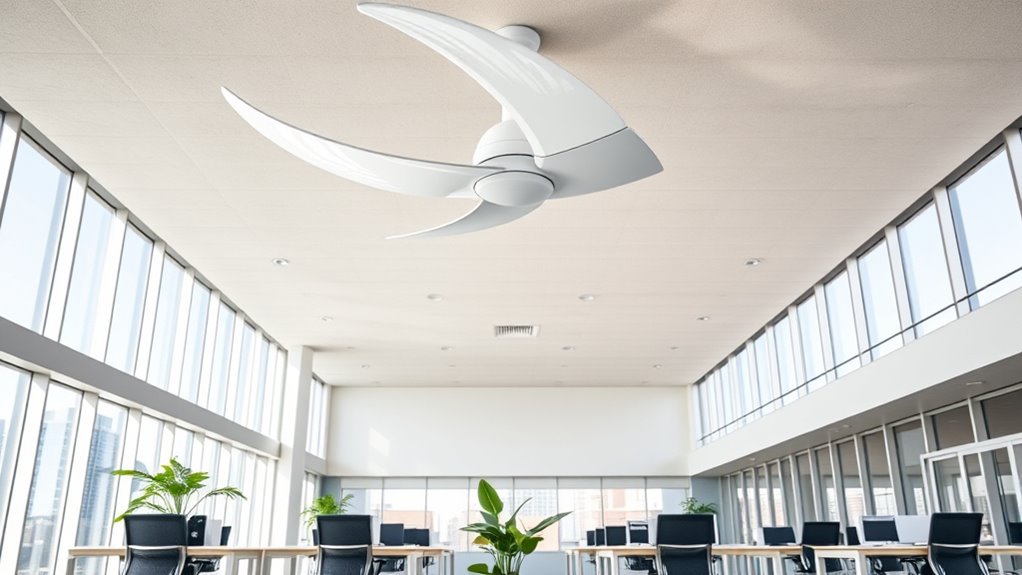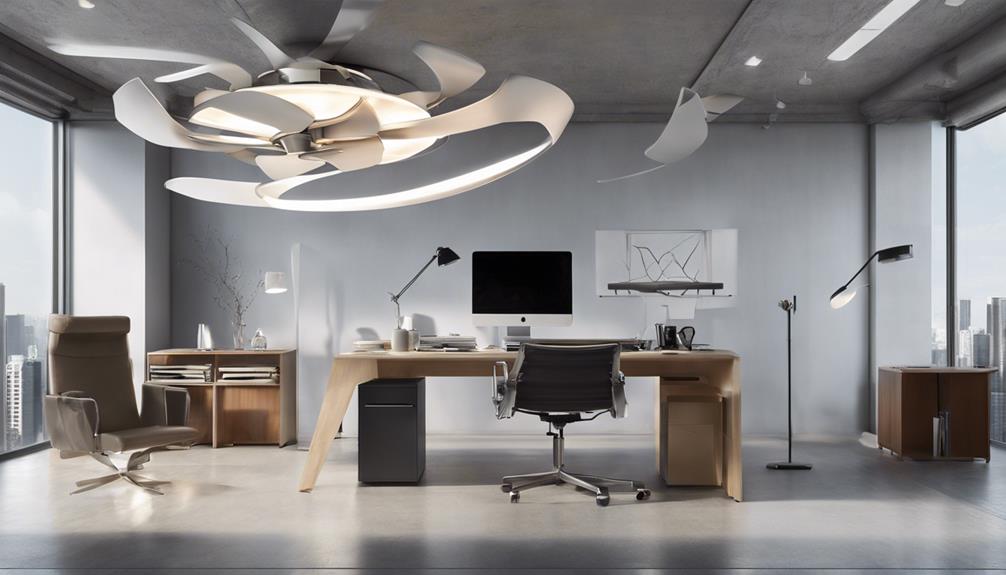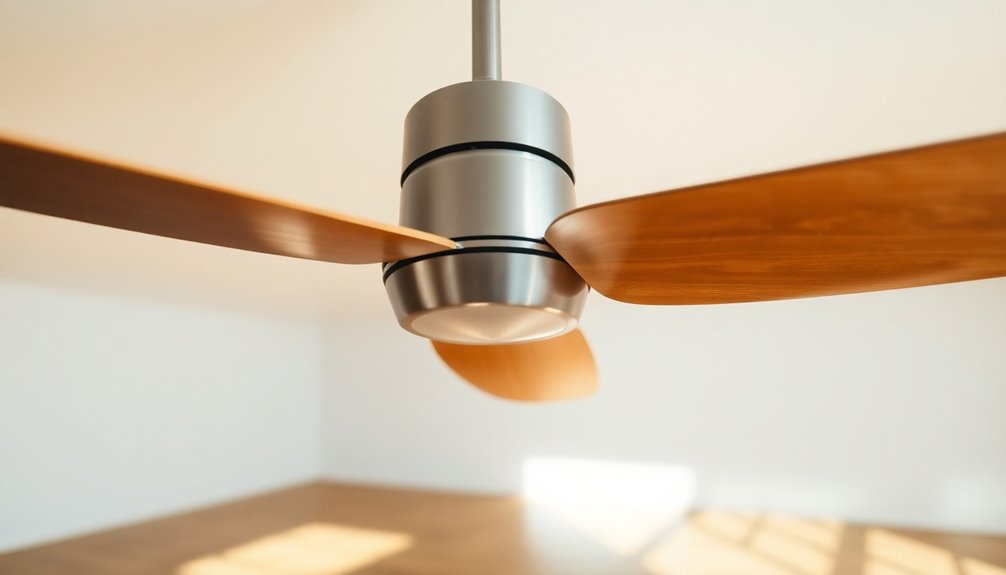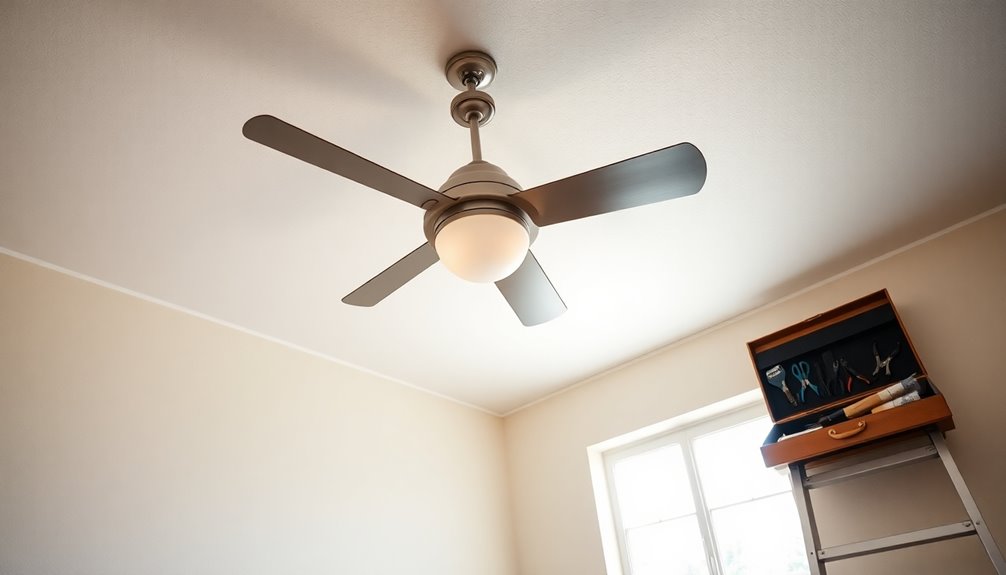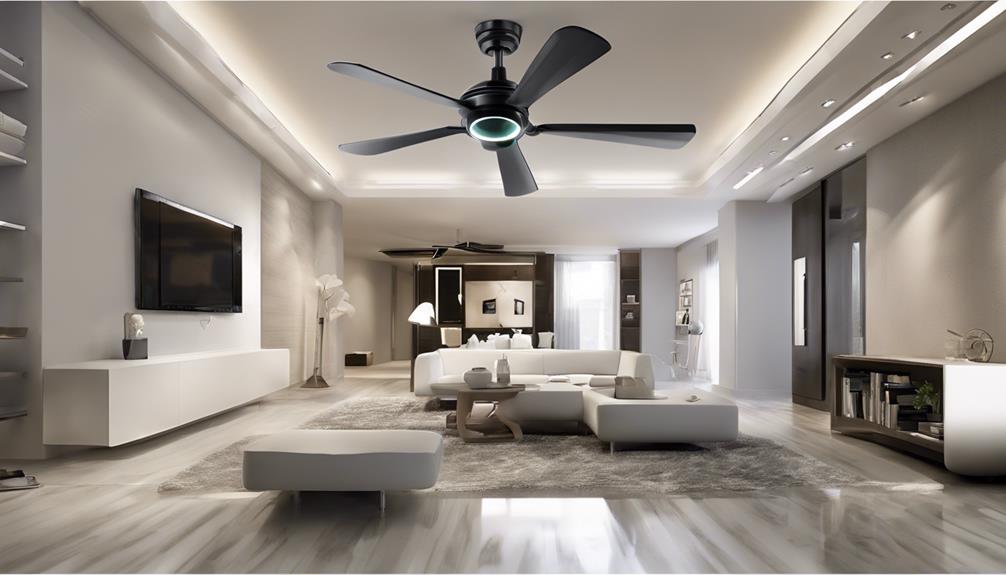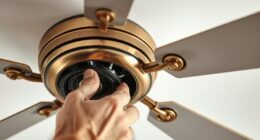To calculate the ideal fan size for open-plan spaces, start by measuring the room’s length, width, and ceiling height to determine its volume. Use this to find the required airflow in CFM, matching it to the space’s size and usage. Consider factors like furniture layout and ceiling height for maximum airflow. If you want to guarantee efficient cooling and comfort, keep exploring how to fine-tune your fan selection.
Key Takeaways
- Measure the total room volume by multiplying length, width, and ceiling height in feet.
- Determine the recommended airflow (CFM) based on the room’s purpose and size.
- Match fan CFM capacity to the room’s volume, ensuring adequate ventilation without over-sizing.
- Consider ceiling height and layout to select fans that provide uniform airflow and comfort.
- Account for noise levels, energy efficiency, and aesthetic fit when choosing the fan size.
Understanding the Importance of Proper Fan Sizing in Open-Plan Areas
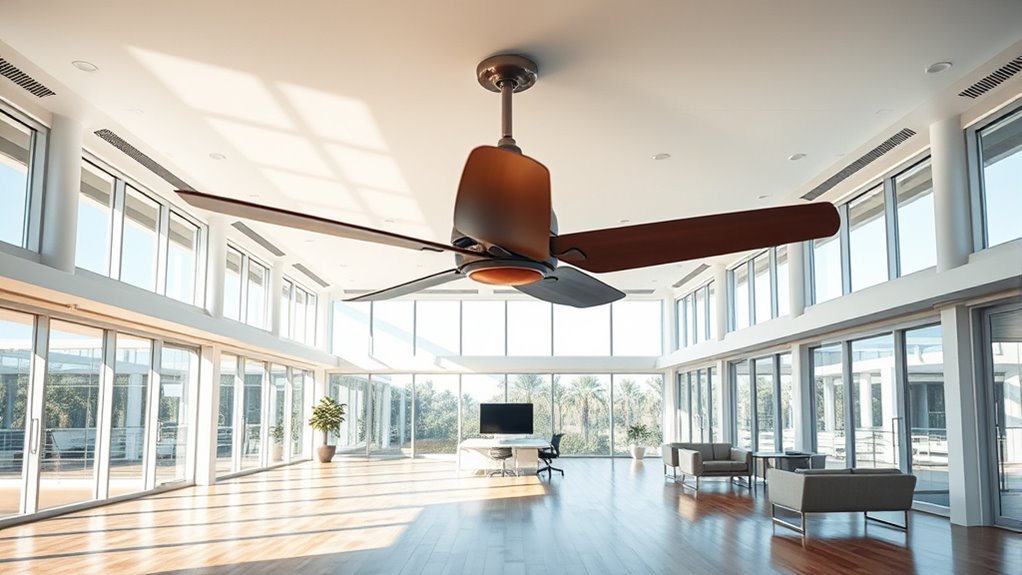
Proper fan sizing is crucial in open-plan areas because an undersized fan won’t circulate air effectively, leading to uncomfortable temperatures and poor air quality. When you choose the right size, you enhance airflow efficiency, ensuring consistent temperature distribution throughout the space. Properly sized fans also help minimize noise, creating a more comfortable environment by reducing the noise generated by the fan’s motor and blades. An appropriately sized fan improves overall air movement without excessive noise or vibration, making your space more pleasant. If the fan is too small, you’ll notice stagnant air pockets and inconsistent cooling. Conversely, a fan that’s too large might produce unnecessary noise and draftiness. Accurate sizing ensures you achieve maximum airflow and quiet operation, making your open-plan area more comfortable and functional. Selecting a fan that matches the space can also prevent the need for additional cooling equipment, which can be more costly and less efficient. Properly matching fan size to room dimensions is essential for optimal performance and comfort, and considering heat pump efficiency ratings can further optimize your climate control setup.
Measuring Your Space: Dimensions and Layout Considerations
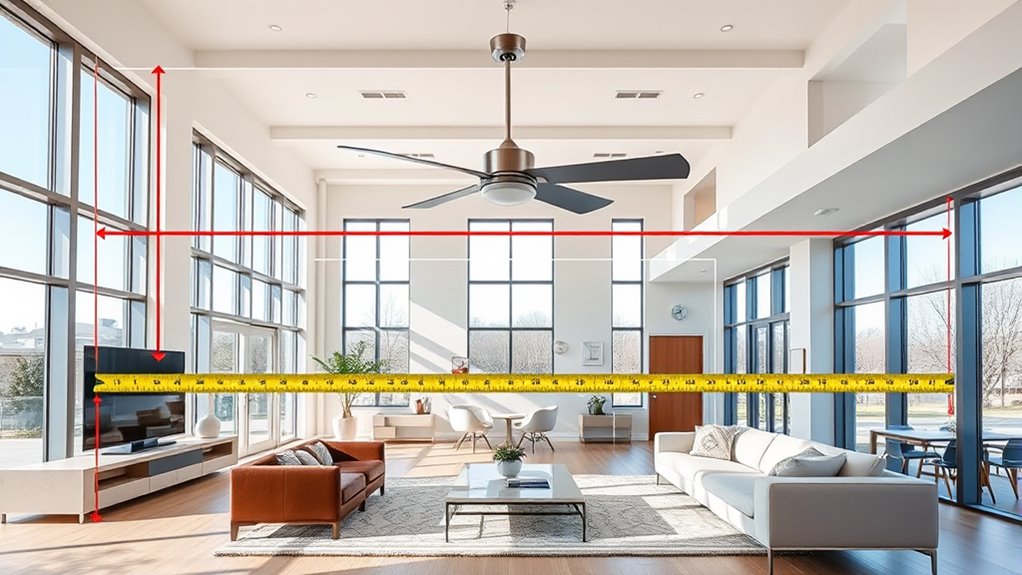
To accurately select the right fan size, start by measuring your space’s dimensions and understanding its layout. Measure the length, width, and ceiling height to determine the total volume of the room. Recognize how your space’s decorative style influences fan choices—modern, traditional, or eclectic designs may call for different fan aesthetics. Also, consider airflow patterns and furniture placement, as these impact how air circulates. A well-measured space helps you choose a fan that’s energy-efficient, avoiding oversized units that waste power or undersized ones that underperform. Keep in mind that layout considerations, such as open-plan configurations and the presence of partitions, influence airflow and cooling needs. Precise measurements and layout insights ensure you pick a fan that enhances energy efficiency while complementing your decor. Additionally, understanding how your space’s air circulation affects comfort can guide you toward selecting a fan with appropriate airflow capacity. Moreover, considering performance metrics can help determine if a fan will meet your specific cooling requirements effectively. When selecting a fan, it’s also helpful to review local building codes and safety standards to ensure compliance and safety in your installation.
Calculating the Required CFM (Cubic Feet per Minute) for Ventilation

Calculating the required CFM (Cubic Feet per Minute) for ventilation is essential to guarantee your space stays comfortable and well-ventilated. To do this, consider your room’s size and activity level. For example, a larger or busier space needs higher airflow. Use this table to visualize:
| Room Type | Recommended CFM |
|---|---|
| Open-plan living | 100-150 CFM |
| Office space | 80-120 CFM |
| Lounge area | 60-100 CFM |
Keep in mind, fan noise can impact comfort, so choose a fan with quiet operation. Additionally, an aesthetic design that blends with your decor guarantees ventilation doesn’t compromise your space’s style. Proper calculation balances airflow, noise, and aesthetic design integration seamlessly. Considering airflow efficiency can help optimize fan performance and energy consumption.
Selecting the Appropriate Fan Size Based on Room Volume
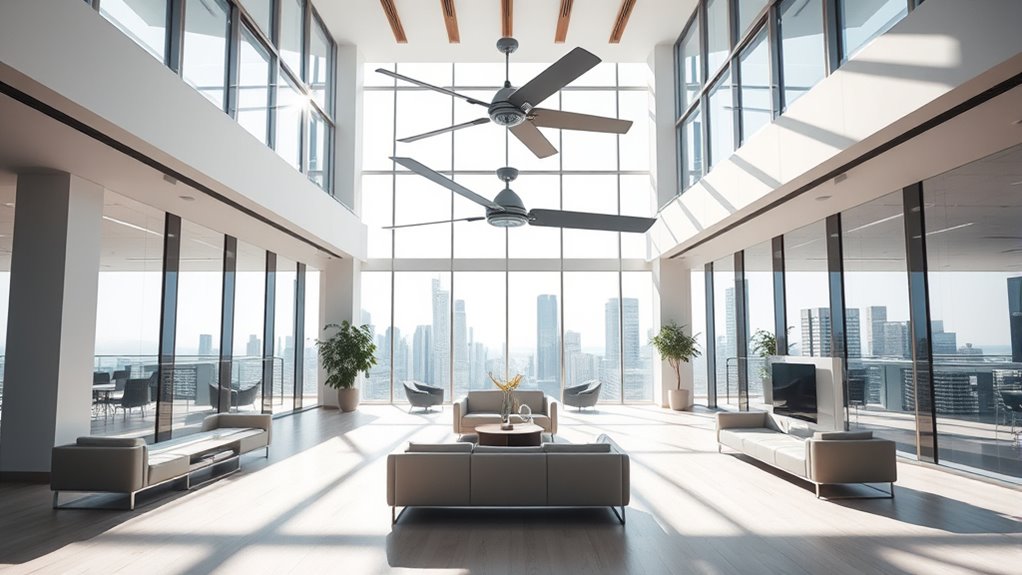
To choose the right fan size, you need to calculate your room’s volume by multiplying its length, width, and height. Once you know the volume, compare it to the fan’s airflow capacity to make certain it can handle the space effectively. Picking a fan that matches your room size guarantees ideal ventilation performance. Additionally, considering effective airflow ensures the fan provides sufficient circulation for open‑plan areas. A proper assessment of building codes and local regulations can also influence the selection process to ensure compliance and safety.
Calculating Room Volume
Understanding your room’s volume is essential for selecting the right fan size because it directly impacts airflow requirements. To calculate it, measure the length, width, and height of your space in feet, then multiply these dimensions together. The result gives you the room’s cubic footage. Larger rooms require fans with higher airflow capacity to maintain comfort, but also consider factors like fan noise, which can increase with larger units. A bigger fan might be more powerful, but it can also be louder, affecting the aesthetic appeal of your space. Knowing your room volume helps you choose a fan that balances performance with noise levels, ensuring it fits seamlessly into your open-plan environment without compromising style or comfort. Additionally, understanding airflow capacity and automation trends can inform your choices about smart, connected fans that enhance your living space.
Fan Airflow Capacity
Choosing the right fan airflow capacity is crucial to guarantee your space stays comfortable. An undersized fan won’t circulate enough air, leaving the room stuffy, while an oversized fan can cause excessive noise and waste energy. To select the proper size, consider your room volume and the desired air changes per hour. A fan with appropriate airflow ensures efficient ventilation without creating unnecessary fan noise or energy consumption. Higher capacity fans move more air but may be louder and less energy efficient if overpowered for the space. Conversely, a fan with too little capacity struggles to maintain comfort. Striking the right balance between airflow capacity, noise levels, and energy efficiency will help you achieve ideal ventilation and comfort in your open-plan space. Additionally, understanding fan performance metrics, such as airflow capacity in CFM or m³/h, can further refine your choice.
Room Size Compatibility
How do you guarantee your fan matches the size of your room? First, measure your space’s volume to select the right ceiling fan styles. Larger rooms need bigger fans or multiple units, while smaller rooms benefit from decorative fans with a more modest blade span. Consider the room’s square footage and ceiling height—these factors influence fan size. A fan that’s too small won’t circulate air effectively, while an oversized fan can create discomfort. By matching the fan size to your room volume, you ensure ideal airflow and comfort. Proper sizing also involves understanding air circulation principles, which helps optimize fan performance for your specific space. Additionally, selecting a fan that aligns with your home’s decor style can enhance the overall aesthetic. Choosing the right fan size is essential for energy efficiency, reducing unnecessary power consumption. Proper sizing enhances both comfort and aesthetics, making your space feel just right.
Factors Affecting Fan Performance and Efficiency
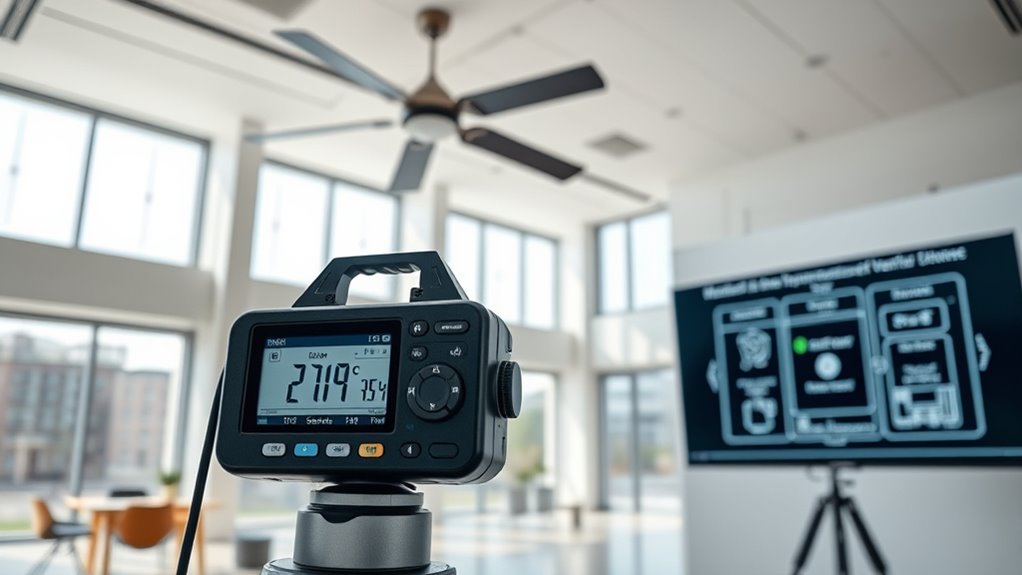
Several factors directly influence a fan’s performance and efficiency, making it essential to contemplate them carefully during selection. Fan blade design plays a crucial role; well-designed blades optimize airflow while minimizing energy consumption. The shape, angle, and material of the blades affect how effectively air is moved and how much noise is generated. Noise reduction features are also vital, especially in open-plan spaces where sound can travel easily. A fan with noise-absorbing components or optimized blade design can operate quietly without sacrificing airflow. Additionally, motor quality and speed settings impact overall performance and energy efficiency. Proper fan tuning ensures the system works harmoniously with the space’s characteristics, leading to better comfort and efficiency. A well-chosen fan can also incorporate energy-efficient motors, reducing long-term operating costs and environmental impact. By considering these factors, you guarantee the fan not only cools effectively but also runs smoothly and quietly, providing comfort without unnecessary noise or energy waste.
Tips for Ensuring Optimal Airflow and Circulation

To accomplish the best airflow and circulation, start by placing your fan in the right spot to cover key areas effectively. Adjust the speed as needed to balance airflow without creating noise or discomfort. Keep an eye on air quality to guarantee your space stays fresh and well-ventilated. Considering the use of air quality monitoring devices can further enhance your environment. Regular maintenance and appropriate ventilation practices also play a crucial role in maintaining optimal airflow.
Proper Fan Placement
Proper fan placement is essential for achieving effective airflow and circulation in any space. To optimize airflow patterns, position fans where they can evenly distribute air without creating dead zones or turbulence. Placing fans too close to walls or corners can disrupt airflow and cause uneven circulation. Keep fans at a comfortable height and angle to promote smooth air movement across the room. Be mindful of fan noise; poorly placed fans may generate distracting sounds or vibrations. Adjust placement to minimize noise impact while maintaining airflow efficiency. Use multiple fans strategically rather than relying on a single unit, ensuring that air flows seamlessly throughout the space. Proper placement helps maintain consistent temperature, reduces energy waste, and enhances overall comfort.
Adjusting Fan Speed
Adjusting the fan speed correctly is key to achieving ideal airflow and circulation in your space. If the fan runs too fast, it can create excessive fan noise, becoming distracting and uncomfortable. Conversely, running it too slow may result in poor airflow, leaving your space stuffy or unevenly ventilated. Find the right balance by setting the speed to match your comfort needs. Keep in mind that higher speeds increase energy consumption, so only use maximum power when necessary. Many fans have adjustable speed settings—use them to optimize airflow without wasting energy. Regularly fine-tuning the speed ensures efficient circulation, reduces noise disturbances, and helps keep your space comfortable and energy-efficient.
Monitoring Air Quality
Monitoring air quality is essential for guaranteeing that your ventilation system effectively promotes healthy and comfortable indoor environments. Regularly check for pollutants, humidity levels, and odors to gauge your space’s air quality. Using air quality sensors helps you identify issues that could compromise ventilation efficiency. If levels of carbon dioxide or volatile organic compounds rise, it indicates poor airflow or inadequate ventilation. Address these problems promptly to maintain ideal circulation. Keep windows open when possible, and ensure your fans and ventilation systems operate correctly. Consistently monitoring air quality allows you to fine-tune your setup, making sure airflow remains balanced and effective. By staying vigilant, you improve ventilation efficiency, creating a healthier, more comfortable space for everyone.
Practical Examples of Fan Size Calculations for Different Spaces

When selecting the right fan size for a specific space, calculating the airflow needed is essential. For example, in a small office, you might use a compact decorative fan style that provides sufficient airflow without overwhelming the room’s aesthetics. In a larger open-plan living area, you’ll need a bigger fan with a higher CFM rating to guarantee proper circulation. Energy efficient fan options are ideal for reducing energy costs while maintaining comfort across various spaces. For retail spaces, choosing a stylish fan that also offers high airflow can enhance the environment. By applying these calculations, you ensure your fan’s size matches the space’s requirements, whether opting for decorative styles or energy-efficient models, optimizing both comfort and design.
Frequently Asked Questions
How Does Ceiling Height Influence Fan Size Selection?
Ceiling height greatly impacts your fan size choice because taller ceilings require more airflow to make certain proper airflow distribution. When ceilings are high, you need a larger or more powerful fan to circulate air effectively and prevent hot or cold spots. If you choose a fan that’s too small, it won’t adequately move air across the space, leading to discomfort. So, always consider ceiling height to select a fan that maintains balanced airflow distribution.
What Are the Signs of an Undersized or Oversized Fan?
If your fan is too small, you’ll notice poor ventilation efficiency, making the space feel stuffy and uncomfortable. An oversized fan can cause excessive noise levels, disturbing your comfort and concentration. Look for signs like inconsistent airflow, overheating, or loud, rattling sounds. Adjusting to the correct size guarantees peak ventilation efficiency and keeps noise levels manageable, creating a more comfortable environment for everyone in the open-plan space.
Can Multiple Smaller Fans Outperform a Single Large Fan?
Imagine a team working together, each bringing their strength to the table. Multiple smaller fans can often outperform a single large fan by improving ventilation efficiency and reducing energy consumption. They distribute airflow more evenly, targeting dead spots, and adapt better to space changes. This teamwork approach guarantees better air circulation, saves energy, and maintains comfort, making your open-plan space more efficient and comfortable overall.
How Do Climate Conditions Affect Fan Size Requirements?
Climate conditions greatly influence your fan size needs. High humidity levels require larger or more powerful fans to improve humidity control effectively. Conversely, in cooler, dry environments, smaller fans may suffice. Additionally, you should consider noise levels, as larger fans tend to be noisier, which might impact comfort. Adjusting fan size based on climate guarantees ideal airflow, humidity management, and minimal noise, creating a comfortable space tailored to your environment.
What Maintenance Practices Optimize Fan Performance Over Time?
Imagine your fan humming steadily, providing cool air on a warm day. To keep it performing well, you should regularly clean blades and filters, ensuring airflow efficiency stays high. Lubricate moving parts and check belts to protect motor longevity. These simple maintenance practices prevent dust buildup and mechanical wear, helping your fan operate smoothly and efficiently over time, so you enjoy consistent comfort without unexpected breakdowns.
Conclusion
When selecting the right fan size for your open-plan space, remember that proper airflow improves comfort and air quality. Did you know that an undersized fan can only move about 50% of the recommended air volume? By accurately measuring your space and calculating the necessary CFM, you guarantee ideal circulation. Investing time now guarantees efficient performance and a comfortable environment, making your open-plan area both functional and revitalizing.
